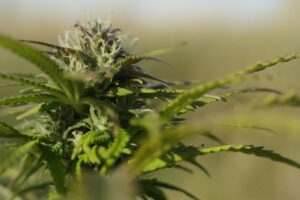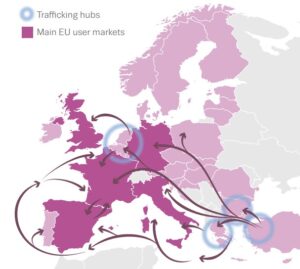The Economy of Addiction

Drug use can be broadly categorized into recreational use, substance abuse, or drug misuse. The pull of drug usage comes from the profound neurological effects that they have on the brain’s synapses. The brain’s neurotransmitters and hormones construct a reward system for survival that encourages activities such as eating and socializing through a feedback loop of dopamine release.
Drug usage, however, can cause a surge of dopamine 10 times larger than that from normal activities, resulting in a high. Overtime, with repeated drug use, the brain becomes immune to larger levels of dopamine being released in the neurological system. It does this by removing receptor proteins along neural pathways, which would have previously allowed dopamine to attach and create a reward pathway. This encourages increased dosages as the user tries to find the same high to replace the now lost feeling of pleasure from daily activities. Though the science of addiction may believe that highly addictive and illegal drugs are weakly price elastic, research trends of the past 20 years have been demonstrating the opposite. It is important to note that price elasticity measures how demand for a product changes related to its price change. For example, an inelasticity coefficient of -1 demonstrates that for every 10 per cent increase in price, there is a 10 per cent decrease in the demand for the product.
Price Elasticity in the Demand for Illegal Drugs
In 2020, a report by the Government of Australia challenged the assumption that there is a completely inelastic demand for illegal drugs by compiling data from both European and North American countries. Instead, the report revealed that demand was more tied to the price of the drug than originally thought. Heroin, a highly expensive drug, had an almost perfectly elastic relationship with price at -0.9, while cocaine followed at -0.84, and marijuana at -0.79. The price elasticity of demand for each drug did demonstrate that there is a decrease in purchasing with an increase in price. With heroin and cocaine being more costly than marijuana, they have a larger price elasticity of demand. However, another theory about the price elasticity for cocaine and heroin rests on the assumption that heroin and cocaine users have greater knowledge of the illegal drug market, meaning these drugs demonstrate a higher elasticity as the users switch between drugs when the price increases. Additionally, researchers in a 2017 study found that higher purity marijuana was less sensitive to changes in price, presumably because the user values the quality of the product over the increase in price.

The UN has identified that when prices fall, drug use increases, leading to a larger aggregate addiction rate. However, if prices increase too much for one drug, substitution may occur instead, creating the appearance of price elasticity for that drug. Most analyses, though, fail to consider that the loss in one section of drug purchase may appear in the form of increased demand for another. In highly addictive substances such as cocaine and heroin, substitution is not an uncommon phenomenon; therefore, failing to account for the possibility of drug substitution within a government’s work to end addiction would be an oversight.
Case Study: The Taliban and Dublin’s Drug Trade
Recent developments in Dublin, Ireland illustrate the challenges of addressing drug demand and addiction. A BBC article published in 2024 reported an 80 per cent increase in problematic crack cocaine use among women in Dublin. The Irish Times observed that heroin addiction previously dominated the city’s drug scene, but crack cocaine’s increased availability has led to a rise in problematic usage. As of 2023, there was a steady decrease in the number of people reporting opioid use, but an increase in reports of cocaine use.
The current situation in Dublin demonstrates the kind of inelasticity and substitution in the drug market that research has not been able to fully analyze. In 2022, prior to the Taliban’s rule, Afghanistan supplied a total of 80 per cent of global opiate demand. This supply was mostly distributed throughout Europe via the Balkan trading route, which reached up into Ireland. However, as of 2022, the Taliban announced a ban on all poppy cultivation in Afghanistan, and since 2023 has actively begun destroying crops. This led to a 95 per cent decrease in the total poppy cultivation in the Afghan province. According to the UNODC, it takes one to one and a half years for the harvested poppy to be transferred into usable heroin. This would explain why, while heroin seizures were still occurring along the Balkan trading route in November of 2022, a present-day heroin shortage could now be occurring in parts of Europe once reliant on this route, including Ireland.

This shortage of heroin creates the opportunity to analyze if illicit drugs really do have an elastic relationship between price and demand, or if substitution with another substance creates the appearance of elasticity in the drug market.
The Path Forward
Overall, the situation in Dublin, and presumably in other countries along the Balkan trading route, leads to an essential takeaway about drug elasticity. As the majority of global drug use is recreational rather than addictive, there would presumably be a total drop in usage within countries experiencing a mass shortage of a drug. However, if there was not a drop in aggregate drug use, it would identify that there was no loyalty to one specific drug, proving that the overall drug market is relatively inelastic regardless of the proven individual elasticities of specific drugs. When there was a shortage of one drug, substitution for another may occur. This would cause the appearance of elasticity, yet overall addiction rates would remain constant. If the aggregate usage were to remain constant along the Balkan route, this could show why supply side policies for a “war on drugs” have been ineffective.
Featured Image: “Opium Poppies” by Richard Croft is licensed under CC BY-SA 2.0
Edited by Alexandra Agosta-Lyon.
